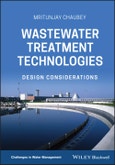Globally, the practice of wastewater treatment before discharge is inconsistent. The United Nations World Water Development Report (2017) estimated that, globally, over 80% of all wastewater is discharged without treatment. The discharge of untreated or inadequately treated wastewater into the environment results in the pollution of surface water, soil and groundwater. According to the WHO, water-related diseases kill around 2.2 million people globally each year, mostly children in developing countries. We need to understand that wastewater is not merely a water management issue - it affects the environment, all living beings, and can have direct impacts on economies.
The establishment of UN Sustainable Development Goal 6 (Clean Water and Sanitation), which aims to ensure availability and sustainable management of water and sanitation for all, reflects the increased attention on water and wastewater treatment issues in the global political agenda. Water reuse is one of the most efficient, cost effective and eco-friendly ways to ensure water resilience. Embedding sustainability into wastewater treatment is the best opportunity for industries to drive smarter innovation and efficient wastewater treatment. The modern concept of industrial wastewater treatment is moving away from conventional design. Wastewater treatment technology is moving towards extreme modular design using smart and sustainable technology.
This book is intended as a reference book for all wastewater treatment professionals and operational personnel. It may also be used as a textbook on graduate and postgraduate courses in the field of wastewater treatment and management. The book takes a holistic view of the practical problems faced by industry and provides multiple needs-based solutions to tackle wastewater treatment and management issues. It elaborates on selection of technology and their design criteria for different types of wastewater. This will enable engineering students and professionals to expand their horizons in the fields of wastewater treatment and management.
Table of Contents
Series Editor Foreword vii
Preface and Acknowledgments ix
List of Abbreviations xi
1 Global Perspective of Wastewater Treatment 1
1.1 Global Wastewater Treatment Scenario 1
1.2 The UN Sustainable Development Agenda for Wastewater 2
1.3 Global Market Size 4
1.4 Global Best Practices 4
1.5 Embedding Sustainability into Wastewater Treatment 7
1.6 Sustainable Sources for Industrial Water 11
1.7 Deep Sea Discharge as an Alternative to Minimize Human and Environmental Health Risks 13
1.8 Environmental Rule of Law 16
1.9 Trends in Wastewater Treatment Technology 17
2 Wastewater Characteristics 19
2.1 Wastewater Characteristics of Various Industries 19
2.2 Wastewater Characteristics and Measuring Methodology 38
3 Wastewater Treatment Technologies 67
3.1 Overview of Wastewater Treatment Technologies 67
3.2 Primary Treatment 68
3.3 Secondary Treatment 73
3.4 Tertiary Treatment 89
3.5 Sludge Dewatering 93
3.6 Zero Liquid Discharge 100
4 Design Considerations 103
4.1 Screening 104
4.2 Equalization Unit 105
4.3 Dissolved Air Flotation 106
4.4 Clariflocculator 108
4.5 Conventional Activated Sludge 110
4.6 Moving Bed Biofilm Reactor 120
4.7 Membrane Bioreactor 124
4.8 Chlorination Unit 130
4.9 Pressure Sand Filter 131
4.10 Activated Carbon Filter 133
4.11 Ultrafiltration 135
4.12 Reverse Osmosis 140
4.13 Evaporator with Crystallizer 146
4.14 Filter Press 149
4.15 Belt Press 152
4.16 Centrifuge 153
4.17 Gravity Thickener 155
5 Advance Sustainable Wastewater Treatment Technologies 158
5.1 Scaleban 159
5.2 Forward Osmosis 162
5.3 Activated Glass Media Filter 165
5.4 Vacuum Distillation 168
5.5 Volute 173
5.6 Solar Detoxification 174
5.7 Sustainable Wastewater Treatment 181
6 Zero Liquid Discharge 184
6.1 ZLD Technologies 185
6.2 ZLD Technologies: Techno-Economic Evaluation 192
6.3 Feasibility Study of ZLD 194
7 Wastewater Treatment Plant Operational Excellence and Troubleshooting 204
7.1 Wastewater Treatment Issues 204
7.2 Wastewater Stream Identification, Characterization, and Segregation 205
7.3 Operation and Troubleshooting for Preliminary Treatment System 205
7.4 Operation and Troubleshooting for Primary Treatment System 206
7.5 Operation and Troubleshooting for Secondary Biological Treatment System 206
7.6 Operation and Troubleshooting for Tertiary Treatment System 213
7.7 Wastewater Sampling 219
7.8 Operation Records and Daily Log Sheet 220
7.9 Microbiology Fundamentals 220
7.10 Biological Wastewater Treatment Factors 223
7.11 Lab Testing Activity and Support 224
7.12 Best Practices for Pipe Line Sizing 226
7.13 Best Practices for Instrument Operation 226
7.14 Wastewater Online Monitoring Process 227
7.15 Wastewater Characteristics Monitoring Parameters 228
7.16 Effluent Treatment Plant Operating Procedure 229
Glossary 231
Index 234








